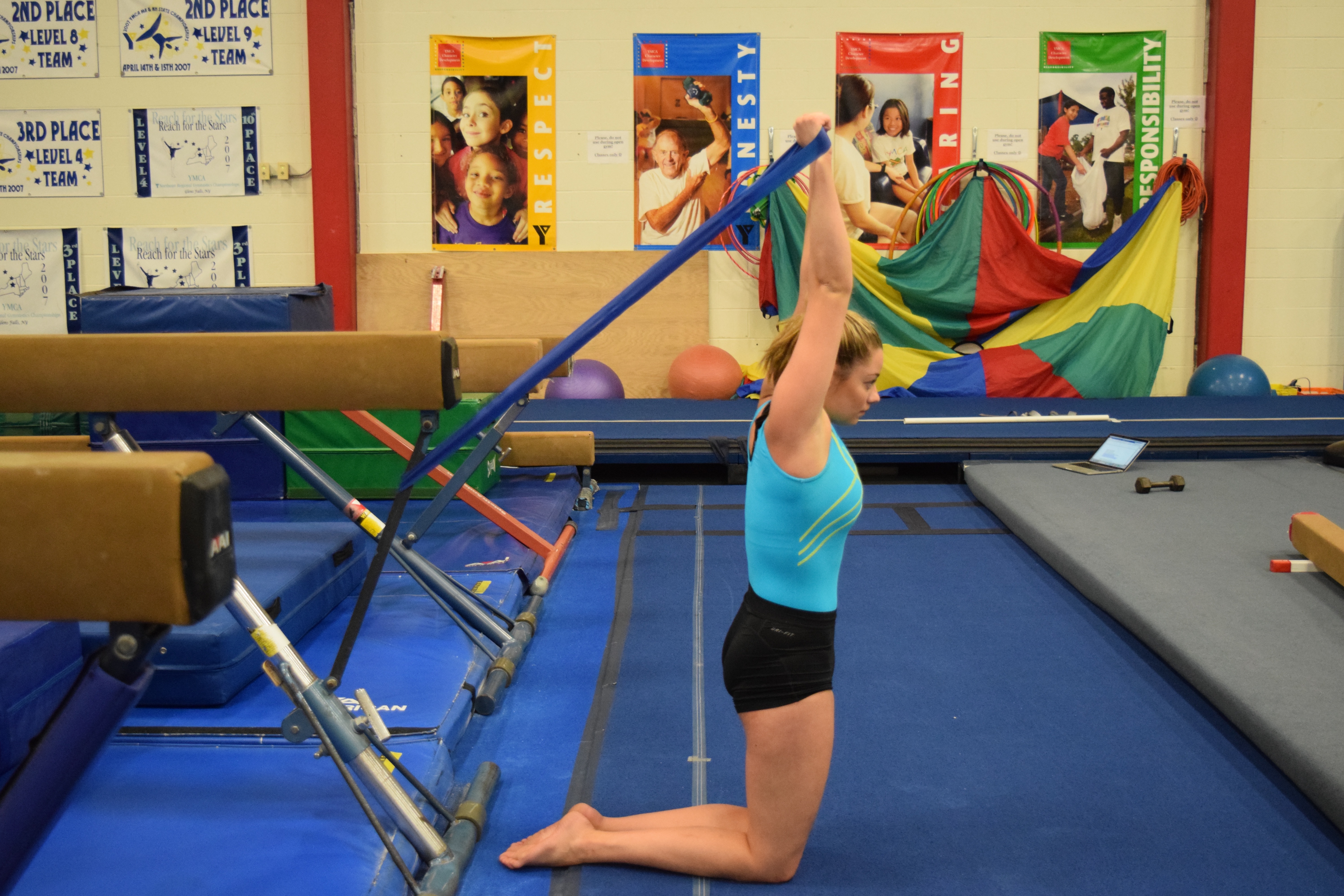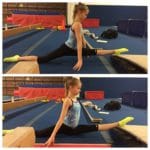Rehab Tips For Clinicians To Treat Gymnasts with Extension Based LBP – Part 3: Intermediate Phase
Over the last few weeks I have been trying to offer some of my thoughts around how I approach the rehabilitation program of a gymnast with extension based back pain. In part 1 I went over calming down acute hypersensitivity and addressing issues above/below. In Part 2 I talked about continuing with local pain management, but also the importance of maintaining dynamic stability of the core, especially if the athlete is braced from a stress fracture. Here’s part 3 with the intermediate phase.
For those looking on al my thoughts on Gymnastics Injuries, be sure to download my free “Gymnastics Medical Care and Rehabilition Ebook”

The Gymnastics Medical Injuries Guide
- Understand the most common injuries in male and female gymnastics, why they occur, and how to prevent them
- Read about the most current science on injuries and rehabilitation in gymnastics
- Get tips on the latest injury risk reduction and rehabilitation practices
We take our privacy seriously and will never share your information. Click here to read our full privacy policy.
Based on the severity of the injury, this phase can happen between 3-6 weeks out. For the athlete that suffered a true symptomatic stress fracture, they usually revisit their doctor and are weaned down in hours per day they wear the brace, pending symptoms are reducing. Those that suffered less severe extension loading irritation are usually well on their way, and may have already started this type of work. The important part for all of these injuries is that when appropriate, we need to make sure we introduce unloaded lumbar movement again. We want to restore the athlete’s confidence in lumbar range of motion in all planes. I think a lot of people get hung up on “core stability” and automatically think that means no lumbar movement. Or, unfortunately the gymnast is scared into thinking they can never extend their back again or it will explode.
Now, I do think we will need to teach the athlete how to protect their spine against multiplanar, high force gymnastics skills by using proper lumbopelvic control (more coming below). But, this needs to be balanced with the fact that gymnastics and daily life requires a large arc of unloaded, low threshold global spinal mobility in all planes.
I don’t want them relying on their lumbar spine as the dominate point of motion during gymnastics, but I also don’t want them to have lingering confidence issues or fear of injuring their back with regular daily spinal movement. It has to be balance of both. Remember, there is an abundance of current pain science thoughts that discuss the importance of perceived confidence, beliefs about their injury, and reversing short term neurological movement adaptations that may have occurred in response to injury. I feel restoring comfortable multiplane spinal motion not only restores the athletes confidence in their spine’s durability, but is a base to restoring neurological movement variability for all of the high level skills coming down the road.

With that said usually around this time I start teasing out a few movements to see where things are at. I do a series of spinal assessments with respond to pain to see the sensitivity levels, and also to see how things are moving together. Remember it’s all symptoms based and some will progress faster/slower based on their individual movement issues.
- Standing multisegmental flexion, extension, rotation and side glide in standing
- Stork Test Bilaterally (Extension Rotation or Quadrant)
- Prone Press Up and Prone Rocking
- Prone on Elbows unloaded Stork
- Seated Compression / Heel Drop Test
- PA Shearing in lumbar region for sensitivity (hard to be specific to level or structures)
At this point depending on their progression and symptomatic pain response I usually start with light unloaded cat camels and other basic spinal movements to introduce the motion lightly.
While restoring unloaded spinal mobility mobility I start to introduce drills for repatterining the global extension and jumping/landing mechanics. Most of the gymnasts I work with have the lumbar spine as their “go to” point of extension with hinge points noted or land very over extended. In order for them to progress in rehab, and ultimately return to high force skills, they will need to repattern their extension to utilize more shoulder elevation, thoracic extension, and hip extension while having very good core control / stiffness as well as use proper landing patterns to disperse force. Here are some of the drills I use a lot.
1. Tall kneeling MSE – We want to help the athlete learn that the shoulders and hips should dominate the motion for extending skills. This will be really important in the return to sport phase when they get back to a progressive exposure to gymnastics program. Although I don’t want to cause more irritation, I usually video tape them do one lumbar dominated and shoulder/hip dominated to break down and explain the difference. You can also add elastic banded RNT resistance at various points to feed the movement your looking for.
2. Supine 90/90 OH Eccentric drops with Breathing at End Range – Similar to the point above, it’s not only about anti gravity along. With tumbling and swinging of the arms they will need to maintain lumbopelvic control with overhead swinging or faster skills. Thats what this drill, and the next drill are for.
3. Tall Kneeling Press and Overhead Anti Extension Press – I think I first saw this drill from Mike Reinold and Lenny Macrina, but I really like it for gymnasts to learn dynamic control with MSE patterns. I use external cues like “keep your hips flat” and “don’t let me see your ears” to help the nervous system self organize around the goal, hopefully helping it to stick automatically with skills. I also want them to cycle a deep breath at the end range to get more local stabilizers kicked in and promote flexion and rib depression / oblique recruitment during full exhales.
4. Basic Hip Hinging, Squatting, and Deadlifting Mechanics – It’s crucial that we start to integrate proper hip hinging and lumbopelvic movements that will eventually become more complex skills. Proper squatting patterns that are hip dominant focusing on eccentric muscular contraction will serve as landing and dismount form to prevent extension overload. Also deadlifting and squatting patterns are used in the later phase of return to sport and reconditioning phase of rehab. Dowel hip hinges, squat drills, and others go well here. Below is a dowel with a single leg, but I also do double leg and other basic squatting re education.
5. Continue to Progress Distal Issues – Just as with other injuries, we want to always be progressing the entire kinetic chain. Based on the movement assessment findings, I always progress shoulder, thoracic and hip extension findings. If mobility has been addressed, progressive control and strength is applied. I also start to load overhead elevation drills, progress shoulder and scapular dynamic stability drills, and add load to single leg/double leg hip lifts. These are a bunch of examples, and I add in the appropriate ones based on the patient, individual movement exam, symptoms, and length of time during rehabilitation.
Concluding Thoughts
I think the biggest take away from this part of the rehab process is the paralleled approach to restoring pain free unloaded lumbar motion, while at the same time educating the gymnast on the need to properly deal with high force gymnastics skills. This will tie into the last two parts of this post where athlete’s are looking at end of formal rehab in the 2-3 month range, where lots of more power and force production/force absorption is focuses on in total movement patterns. I will cover the importance of all planes of both movement and anti movement drills, as well as integrating the entire kinetic chain to create and disperse force. Take care,
Dave Tilley, DPT, SCS









